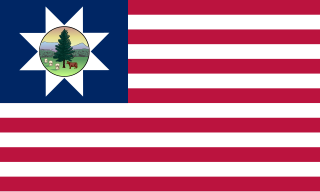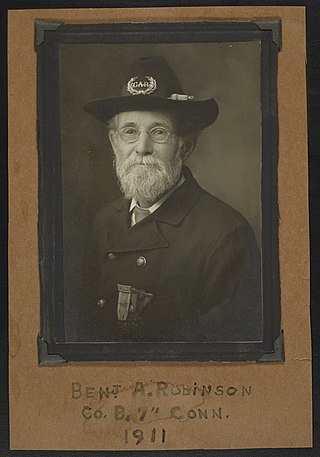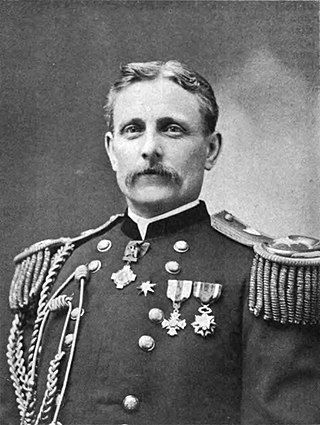
The 1st Vermont Infantry Regiment was a three months' infantry regiment in the Union Army during the American Civil War. It served in the eastern theater, in and around Fortress Monroe, Virginia.

The 13th Vermont Infantry Regiment was a nine months' infantry regiment in the Union Army during the American Civil War. It served in the eastern theater, predominantly in the Defenses of Washington, from October 1862 to August 1863. It was a member of the 2nd Vermont Brigade.

The 2nd Wisconsin Infantry Regiment was an infantry regiment that served in the Union Army during the American Civil War. It spent most of the war as a member of the famous Iron Brigade of the Army of the Potomac. It suffered the largest number of casualties as a percentage of its total enlistment of any Union Army unit in the war.
The 3rd Wisconsin Infantry Regiment was an infantry regiment that served in the Union Army during the American Civil War.

The 6th Wisconsin Infantry Regiment was an infantry regiment that served in the Union Army during the American Civil War. It spent most of the war as a part of the famous Iron Brigade in the Army of the Potomac.
The 14th Wisconsin Infantry Regiment was a volunteer infantry regiment that served in the Union Army during the American Civil War. Four of its members received the Medal of Honor for service in the Second Battle of Corinth, October 3 and 4, 1862; among them the Color-Sergeant Denis Murphy, who, though wounded 3 times, continued bearing the colors throughout the battle.
The 24th Wisconsin Infantry Regiment was a volunteer infantry regiment that served in the Union Army during the American Civil War.

George Haven, born in New London, Connecticut, on March 27, 1844, was the thirtieth Adjutant General of the State of Connecticut. He was the son of Urbane and Sarah (Rogers) Haven. Both were members of old Connecticut families. Haven acquired his education early in public schools of New Haven. He loved books, but with the rumors of war he joined the National Guard at the age of 17. After being discharged on November 19, 1864, Haven returned home to New London and worked for the Wilson Manufacturing Company, with which he was connected for 18 years. He left the employ of the Wilson Company at around 1886, and the next year went to work for the Quinnipiac Company. In 1888 he was appointed Chief of police of New London. Haven served at the City of New London for six years as Alderman and Councilman.
The 9th Iowa Infantry Regiment was an infantry regiment that served in the Union Army during the American Civil War.

The 9th New York Infantry Regiment was an infantry regiment that served in the Union Army during the American Civil War. It was also known as the "Hawkins' Zouaves" or the "New York Zouaves."

The 7th Connecticut Infantry Regiment was an infantry regiment that served in the Union Army during the American Civil War. Because it was in the same brigade as the 7th New Hampshire Volunteer Regiment, both regiments were often jointly called the '77th New England'.

The history of the Arkansas State Guard and the Spanish–American War begins with the reorganization of the state militia following the end of Reconstruction. In 1879 the Arkansas Legislature had abolished the office of Adjutant General in retaliation for the use of the state militia to interfere in local political matters during reconstruction. During this period the Governor's Private Secretary performed the duties of the Adjutant General as an additional duty, and the legislature provided no appropriated funds for the state guard. Several companies existed during this period, including the Quapaw Guards and the McCarthy Guard in Little Rock. In 1897 the Arkansas State Guard was reorganized to consist of four infantry regiments, two artillery batteries and a cavalry squadron. In 1897, the state provided two volunteer infantry regiments for the Spanish–American War and although these two Arkansas Volunteer Infantry Regiments were not deployed overseas and did not see actual combat, they did suffer a number of casualties from disease.
The Adjutant General of Maryland is the head military official of the Maryland National Guard, the Maryland Defense Force, and any other military or paramilitary units that may be maintained by the State of Maryland. The adjutant general is responsible for the military department's budget and maintains all State-owned armories in Maryland.

The Governor's Guards is a historic unit of the Florida Army National Guard, stationed in Tallahassee, Florida. Its current designation is Troop C, 1st Squadron, 153rd Cavalry. The unit has one of the oldest continuous lineages in the Florida National Guard. In 1857, Captain John Parkhill, his brother Samuel M. Parkhill, and Theordore Brevard, Jr. formed a mounted company of "Leon Volunteers" to fight in the Third Seminole War, where John Parkhill was killed in action. John Parkhill's cousin, Captain George W. Parkhill and his brother, Richard C. Parkhill formed a new company called the "Governor's Guards" circa 1859-1860 which later changed its name to "Howell Guards" and fought with the Second Florida Infantry during the Civil War. After the war, the company reorganized as "Governor's Guards", a local militia company, under the command of Captain Alexander Moseley and have had a near-continuous lineage henceforth. The Governor's Guards served as an infantry unit for most of its existence, including in the Civil War, World War I, World War II, the Iraq War and the Global War on Terrorism. The unit consolidated with the Franklin Guards, a detachment in Apalachicola and since 2007 has been Charlie Troop, a dismounted infantry reconnaissance troop.
Justin Hodge, born in Roxbury, Massachusetts on April 21, 1815, was a Connecticut politician who served in the state legislature for many years. He represented his hometown of Barkhamstead as a loyal member of the Democratic Party. He served in the U.S. Army during the Civil War as well as the Mexican War before that. He briefly served as the Adjutant General of Connecticut in 1855.
Elihu William Nathan Starr, born in New Haven, Connecticut, on August 10, 1812, was the ninth Adjutant General of the State of Connecticut. He was later elected to the position of town clerk for the City of Middletown. He also served as treasurer and Judge of Probate

Edward Elias Bradley was the twenty eighth Adjutant General of the State of Connecticut. Bradley served as president of the Boston Buckboard and Carriage Company. He also headed the News Publishing Company. Bradley during 1901 to 1903 was the president of the New Haven Chamber of Commerce. He was commissioner of the public parks of New Haven from 1888 to 1901, and in 1910 became the president of the parks commission. Bradley was president of the Governor’s staff Association of Connecticut from 1903 to 1911. Bradley was president of the Defender Monument Association, which raised funds for the defenders monument to commemorate the successful defense of the West River. He was also the president of the Young’s Men Institute. In 1883, Bradley represented the town of Orange, Connecticut in the general assembly. Bradley was a Democrat and introduced and advocated the constitutional amendment for biennial sessions of the Legislature, which was accepted. He was the director of New Haven National Bank and was the director of Quinnipiac Fire Insurance.
Charles P. Graham, was born in Utica, New York, and was the twenty ninth Adjutant General of the State of Connecticut. Graham was one of the original dental commissioners of the state being first appointed in 1893. In 1896 he served as president of the State Dental Society. Graham was a prominent member of the Universalist Church. He practiced dentistry for 36 years.

George Malpas Cole, was the thirty-second Adjutant General of the State of Connecticut. He was the son of George Cole and Jane A. Malpas. Born in Portsmouth, England, his family moved to Massachusetts where his father was a civil engineer. Cole was educated in public and private schools. Cole was also tutored by his father, where he became an assistant to his father. Cole would later become associated with a wholesale and a grain business in New London.

The 3rd Virginia Volunteer Infantry Regiment was an infantry unit of the United States Army, mustered into Federal service during the Spanish–American War.









